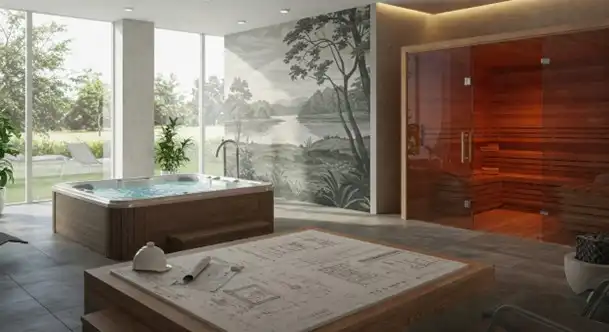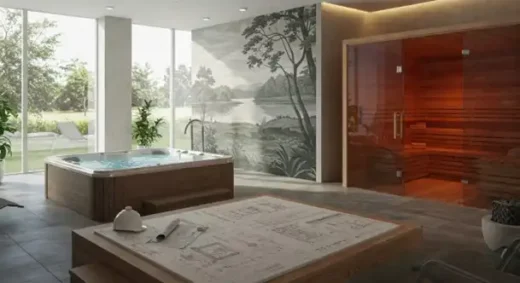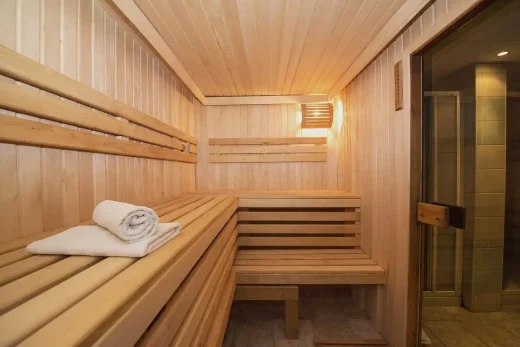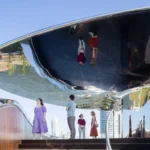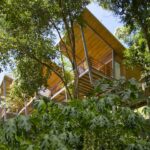4 smart spa solutions architects leverage guide, Home hot tub cover lifters and clip
4 Smart Spa Solutions Architects Are Leveraging Today
30 April 2025
Wellness is constantly evolving. For architects, this presents an exciting frontier in spa design. This sector demands a nuanced understanding of aesthetics, mindfulness, technology, and even sustainability.
Today’s spa design is about crafting personalized, immersive experiences that cater to a more discerning and health-aware clientele. Let’s dive into some key trends shaping the future of spa design.
1. Safety, Hygiene, and Modular Convenience
Spa design must prioritize hygiene and safety.
Materials should be easy to sanitize. Designs should be breathable and reduce touchpoints. Architects are integrating sanitation stations without disrupting the serene ambiance of the spa, such as:
- Sleek, non-porous surfaces
- Discreet ventilation systems
- Hand sanitizing units
Social distancing and accessibility are now key priorities in spa design. Architects are designing larger environments, with ample distances between treatment areas and relaxation rooms.
Accessible designs include:
- Safety ramps
- Improved (wider) doorways
- Adaptable treatment spaces
Flexible and modular design trends are recognizing the diverse needs of spa operators and clientele.
Architects are developing adaptable spa components that can be reconfigured to fit a variety of treatments, group sizes, or even future trends. Take treatment areas with movable partitions or relaxation areas with flexible seating arrangements.
Even seemingly small details, like easily adjustable hot tub cover lifters and clips, contribute to this adaptability.
2. Natural, Environmental, and Sensory Design
Natural materials and biophilic design are both ideally suited for spa construction.
Design elements like warm wood, textured stone, and vibrant greenery engender a sense of calm and tranquility.
A few examples include:
- Treatment rooms designed for natural light
- Strategically placed indoor plants
- Indoor water features in relaxation lounges
Research also concludes that biophilic design can reduce stress, boost mood, and even accelerate healing.
Biophilic and sustainable design work to progress spa design through:
- Sustainable and locally sourced materials
- Energy-efficient HVAC and lighting systems
- Natural ventilation
- Rainwater harvesting
Also, noteworthy: upcycled or recycled materials are becoming the new badge of honor in responsible spa design.
These design features also appeal to the senses.
Designers carefully orchestrate soundscapes with calming nature sounds and ambient music. Dynamic lighting adjusts to the time of day, and temperature variations are used to enhance comfort.
3. Technology, Biohacking, and Immersive Experience
Technology integration is ever-evolving. Notable innovations include:
- Adaptable Smart lighting systems with mood controls
- Built-in music systems (controlled by guests)
- Temperature controls in treatment rooms
The goal is to create a seamless and intuitive experience where technology enhances, rather than intrudes upon, the spa experience.
Biohacking is also influencing spa design.
The aim is to optimize human performance and well-being. Current trends include:
- AI-driven assessments to personalize wellness recommendations
- Dedicated spaces for sleep optimization
- Soundproof nap pods with circadian rhythm lighting
- Cold therapy sessions like cryo-saunas
Immersive spa experiences are gaining traction. Architects are leveraging technology to transport guests beyond the physical spa environment.
For example, virtual reality relaxation rooms can whisk clients away to serene beaches and tranquil forests. Carefully designed storm simulation rooms offer unique and cathartic sensory experiences.
4. Aesthetics, Mindfulness, and Spa Culture
Aesthetic considerations are crucial. Spa architecture emphasizes visually soothing and harmonious environments.
Designers work with a palette of mood lighting and calming colors, utilizing soft, natural hues that promote relaxation. Curves and soft edges create a sense of flow and organic comfort, moving away from harsh angles and rigid lines. Accent lighting highlights architectural details and artwork, creating a layered ambiance.
Spa architects thoughtfully design the flow of the user’s journey, from arrival to treatment to post-treatment.
Some examples are:
- Dedicated meditation rooms bathed in soft natural light
- Tranquil tea ceremony spaces
- Beautifully designed areas for post-treatment reflection
It’s about creating a seamless and meaningful progression through the spa experience.
Look for innovations in soundproofed (and aesthetically pleasing) spaces that ensure privacy and quiet for guests to fully unwind. Careful attention is paid to acoustics, lighting, and ventilation to create a cocoon of tranquility.
Sauna culture is also experiencing a resurgence and evolution.
Architects are designing more comprehensive sauna areas that go beyond traditional dry heat. This includes:
- Cold plunge pools for contrast therapy
- Reviving snow rooms for unique sensory experiences
- Beautifully designed relaxation areas
These details foster healing and holistic sauna experiences.
Stay Updated On the Spa Sector
The future of spa design is a dynamic and multifaceted field. It demands a deep understanding of wellness principles, technology, environmental awareness, and, ultimately, the human need for sanctuary and rejuvenation.
By embracing these trends, architects can create spaces that not only look stunning but also nurture the mind, body, and soul.
Comments on this guide to 4 smart spa solutions architects leverage article are welcome.
Home Saunas and Hot Tubs
Home Saunas
How custom sauna design adds luxury elegance to home
Reimagining relaxation in home saunas
How long should you stay in sauna guide
Hot Tubs
Inflatable hot tubs ultimate backyard oasis
Cutting costs of hot tub and swimming pool installation
Property
Contemporary Property Articles – architectural selection below:
Comments / photos for the 4 smart spa solutions architects leverage page welcome.

